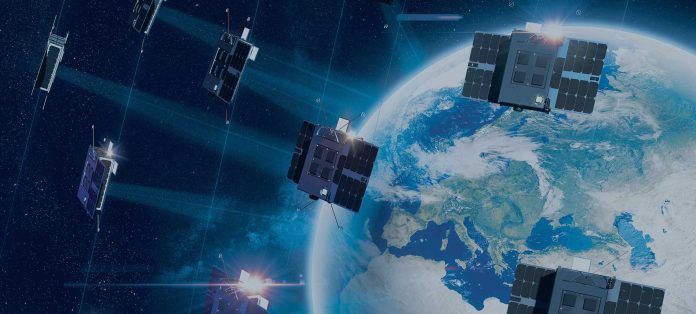US LoRaWAN network operator and cloud provider Senet has partnered with European satellite operator Eutelsat Communications, together with US-based LoRaWAN and GPS tracking solutions provider TrakAssure, and UK-based LoraWAN (and Bluetooth and Wi-Fi mesh) network provider Wyld Networks to integrate terrestrial and satellite LoRaWAN IoT connectivity and plug gaps in coverage in rural areas, shipping and transport routes, and other hard to reach areas.
The quartet has formed a consortium, the Multimodal IoT Infrastructure Consortium (MMIIC), to formalise and complete technical tests, pilots, and commercial delivery of a “first-to-market” low-power wide-area (LPWA) solution for the supply chain industry that combines both terrestrial and satellite LoRaWAN connectivity. The group said it will follow with new LoRaWAN solutions combining low-earth orbit (LEO) satellites and terrestrial network connectivity.
The initial test work is to check LoRaWAN-based IoT sensors can switch between Senet’s terrestrial LoRaWAN network and Eutelsat’s low-earth orbit (LEO; also Eutelsat LEO for Objects, in Eutelsat product marketing parlance) nanosatellites without a hitch. Senet will provide terrestrial LoRaWAN connectivity and offer Eutelsat satellite coverage through its ‘extended coverage’ services, which taps into partner networks, including from the likes of network crowd-sourcing outfit Helium.
IoT devices will connect to Senet terrestrial networks by default and automatically switch to satellite when coverage gaps are recognized. TrakAssure and Wyld Networks are collaborating on the new supply-chain IoT devices. Wyld Networks is designing and producing the hardware module and firmware. TrakAssure will offer terrestrial and satellite LoRaWAN, including for temperature monitoring, geofence alerts, delivery proofs, and other visibility requirements.
The companies expect to launch commercial services in the second half of the year, with pilots beginning next month (February). A statement said: “Through platform integrations, innovative sensor and hardware design, collaborative service delivery, and compelling pricing, the companies are targeting the global supply chain, including container logistics and related asset tracking, as the first and anchor applications.”
Luc Perard, senior vice president of IoT at Eutelsat, said: “Existing LPWA networks, including LoRaWAN, are ideal to connect assets that don’t send much data and need to operate on a low power budget. But they rely on terrestrial infrastructure, such as LoRaWAN gateways, which will never cover more than extended urban areas, i.e. less than 15 percent of the Earth’s surface.
“Eutelsat will enable network operators like Senet to propose… hybrid terrestrial-and-satellite LoRaWAN connectivity, over land and sea, at the same low-price points. Because ELO is fully compatible with the LoRaWAN standard, IoT solution providers and device manufacturers like TrakAssure and Wyld can easily, rapidly and inexpensively adapt their existing LoRaWAN products to make them ELO-compatible and benefit from up to 100 percent Earth coverage.”
Bruce Chatterley, chief executive at Senet, said: “A comprehensive and cost-effective strategy is needed to deliver robust coverage across a geography as massive as the US. Senet’s terrestrial network, extended coverage through partners like Helium, innovative virtual network program, and now satellite [coverage] creates the first and only true-global LoRaWAN IoT network, covering any geographic area required.”
He added: “This capacity is especially important to logistics applications and is another example of Senet innovating based on unique market and customer requirements.”
Don Miller, board member at TrakAssure, said: “We are very excited to be part of a consortium launching the world’s first LoRaWAN direct-to-satellite with terrestrial dual-mode network compatibility. The combined effort will usher in a fresh, cost effective and carrier grade solution opening up new applications in logistics and global asset tracking markets by not only leveraging cost-efficient terrestrial based LoRaWAN solutions, but now expanding capability with ubiquitous global connectivity via satellite which even existing cellular solutions cannot support.”
Alastair Williamson, chief executive at Wyld Networks, said: “The lack of affordable wireless coverage is holding back the growth of the Internet of Things from contributing an additional $2 trillion to $3 trillion in value to global GDP over the next decade. Combining two advanced frontier technologies of LoRaWAN and Low Earth Orbiting satellites we can enable 100 percent global, affordable and low power connectivity to support IoT deployments in multiple markets and segments.”

